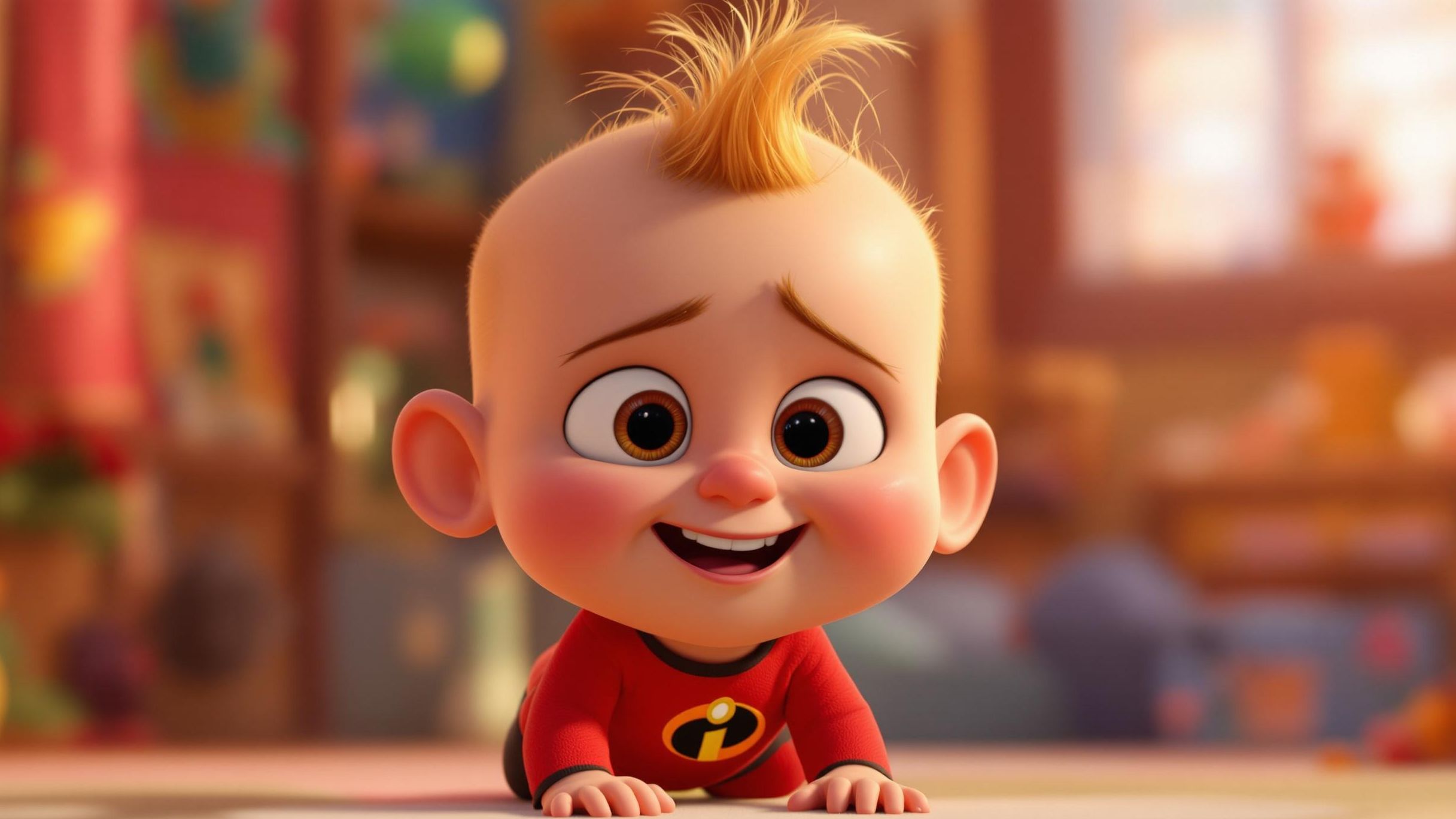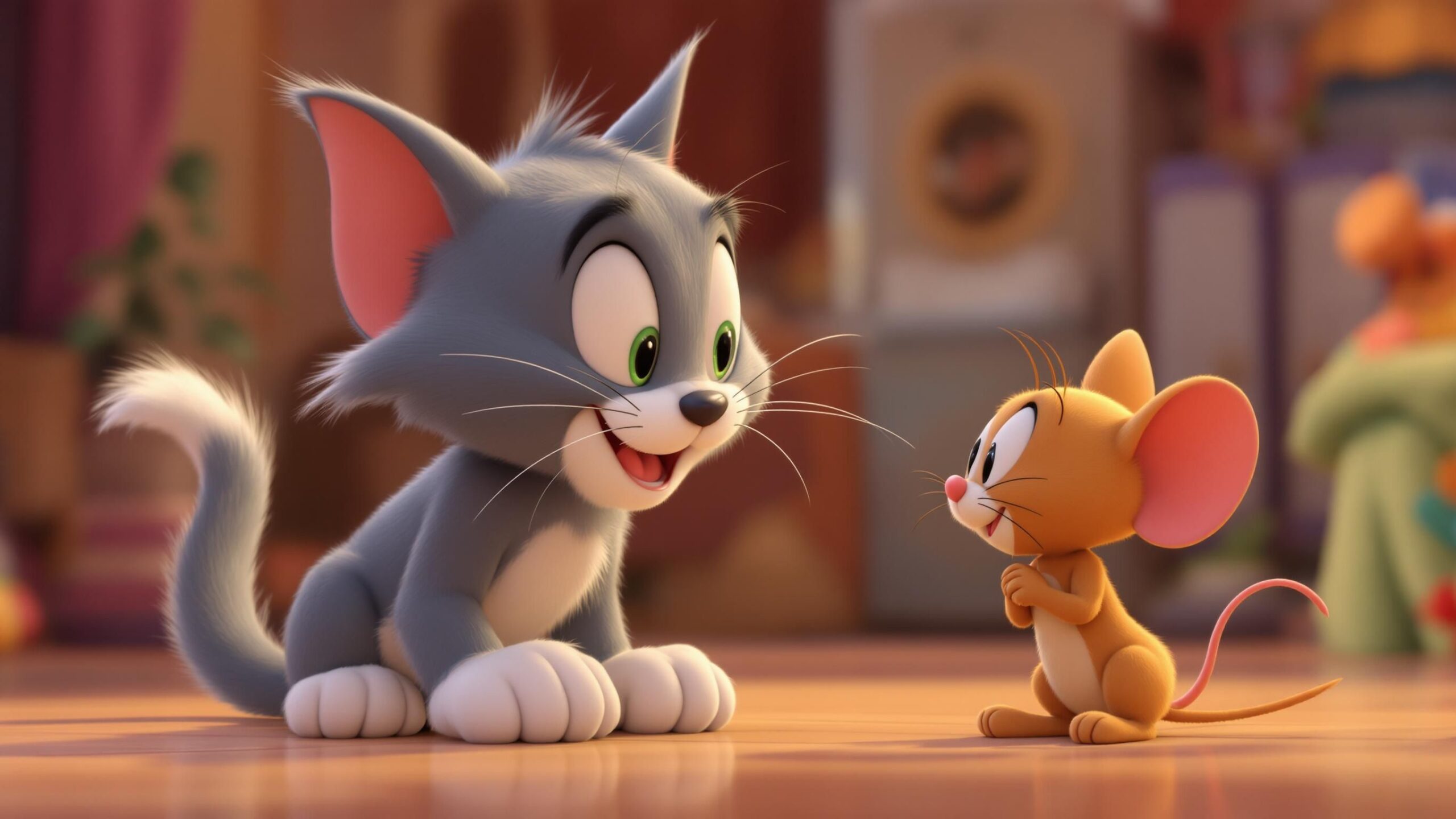In a family packed with superheroes, Jack-Jack Parr might look like the most harmless member—just a chubby-cheeked baby with a love for cookies and giggles. But anyone who’s seen The Incredibles and Incredibles 2 knows the truth: this baby is an absolute powerhouse. With dozens of unpredictable abilities and zero control over when or how they appear, Jack-Jack is pure, unfiltered super-powered chaos. While Dash sprints and Violet shields, Jack-Jack burns, teleports, clones, levitates, and morphs into a flaming demon—all before nap time. These scenes prove that Jack-Jack isn’t just cute—he’s an unstoppable force of superhero mayhem.
#10: Jack-Jack vs. the Raccoon
The backyard battle between Jack-Jack and the raccoon is one of the funniest and most jaw-dropping scenes in Incredibles 2. What begins as a curious baby watching an animal dig through trash turns into a Looney Tunes-style super-fight that showcases a shocking array of powers. Jack-Jack uses laser vision, cloning, phasing, fire transformation, and even brute strength—all while giggling with delight. The raccoon has no idea what it’s up against as Jack-Jack pummels it with every ounce of baby vengeance.
This scene is more than just a gag. It’s the first time the audience sees the full scale of Jack-Jack’s powers in action. Up until now, only the babysitter and the audience had hints of his abilities. But this backyard brawl reveals he’s not just a toddler with a single talent—he’s a Swiss army knife of superpowers. The scene is so well-animated, with comedic timing and visual creativity, that it instantly became one of the most talked-about moments in Pixar history. It’s also a turning point in the story where Bob realizes that parenting Jack-Jack may require more than diapers and lullabies—it may take armor.
#9: Jack-Jack and Edna’s Power Montage
When Bob is desperate for a break, he drops Jack-Jack off at Edna Mode’s ultra-futuristic lair. The result is one of the most dazzling, hilarious, and satisfying training montages in any animated movie. As Edna analyzes and tests Jack-Jack’s abilities, the baby effortlessly floats, clones, combusts, zaps lasers, and turns into goo—all with that signature baby grin.
What’s amazing here is Edna’s complete lack of fear. While everyone else panics around Jack-Jack’s powers, Edna is thrilled. She claps, takes notes, and even offers Jack-Jack cookies while casually watching him burst into flames. It’s a masterclass in character contrast—her cool brilliance against Jack-Jack’s chaotic brilliance. The montage not only highlights his powers but introduces his new super suit, custom-built to withstand and react to his shifting abilities. From fabric that extinguishes fire to sensors that detect dimensional phasing, Edna has made the baby battle-ready.
This sequence is both comedic and essential to the story. It demonstrates how Jack-Jack is not just a baby with potential—he’s a game-changing hero in his own right. And with Edna as his unofficial mentor, he’s got the fashion and tech to match his super status.
#8: Dimension-Hopping on the Villain’s Ship
In the climax of Incredibles 2, as the Parr family fights to stop the runaway ship from crashing, Jack-Jack takes his antics to a whole new level. At one point, he phases through a locked glass room, disappearing and reappearing in different areas of the ship. He flickers through dimensions like it’s nothing, popping into midair, through walls, and into chaos—completely unbothered.
This scene demonstrates Jack-Jack’s most terrifying truth: he doesn’t obey the laws of physics. He doesn’t even understand the concept of obstacles. While the other heroes are strategizing and sprinting, Jack-Jack is breaking space and time like he’s hopping across puddles. It’s comical, mind-bending, and proves once again that his powers exist on a different plane from everyone else’s. He’s not a baby superhero—he’s something cosmic. And he’s not even aware of it.
#7: Demon Baby vs. Syndrome
In the final act of the first Incredibles, Syndrome tries to kidnap Jack-Jack, assuming the baby is powerless. Big mistake. Jack-Jack immediately morphs into his demon form—fiery, snarling, with glowing red eyes—and unleashes chaos midair. He scorches Syndrome’s cape, transforms into solid metal, and generally terrifies the villain into submission. The visual of this tiny baby becoming a hellish creature is both hilarious and epic.
This moment is especially satisfying because it serves as the ultimate reversal. Syndrome, who spent the whole film trying to control and mock superheroes, is taken down by a baby he didn’t even consider a threat. Jack-Jack’s demon form is more than just a punchline—it’s the ultimate statement: underestimate this baby at your own peril.
#6: Cloning Chaos in the Backyard
Back in the raccoon fight, there’s a particularly wild moment where Jack-Jack clones himself into multiple versions. Suddenly, the raccoon is surrounded by identical babies, each attacking from a different angle. It’s adorable and terrifying all at once. The precision with which Jack-Jack controls his clones—without even knowing he’s doing it—underscores how instinctively powerful he is.
This scene raises fascinating possibilities. Could Jack-Jack create an army of himself? Could each clone access different powers? The implications are endless, and while the movie doesn’t explore them fully, this moment is a window into what he might be capable of in the future. For now, it’s just the raccoon’s worst nightmare—and our comedic gold.
#5: Calm Levitation in Edna’s Lab
Among all the chaos of Jack-Jack’s powers, there’s one serene and mesmerizing moment—he floats. Not like a stumble or hover, but a full-on levitation, seated mid-air with a peaceful expression. This scene, tucked into Edna’s montage, is a quiet reminder that Jack-Jack isn’t just chaotic. He’s also capable of beauty and grace.
Levitation typically requires mastery in superhero lore. For Jack-Jack, it’s just Tuesday. It’s visually stunning and symbolically powerful—a literal ascension for a character we assumed was just comedic relief. Instead, he’s evolving before our eyes.
#4: Jack-Jack Phases Through Everything
One of the most disorienting and mind-boggling displays of Jack-Jack’s strength is his ability to phase through solid matter—walls, furniture, glass, even other people. We see this most clearly during the sequence in the Deavors’ compound, where Bob is trying to keep Jack-Jack contained and fails miserably. Every time Bob thinks he’s cornered the baby, Jack-Jack just slips through the nearest object like a giggling ghost, vanishing with a shimmer and popping out somewhere else.
This moment isn’t just funny—it’s downright unsettling in the best way. Phasing, or molecular intangibility, is one of the most dangerous and versatile powers in superhero lore. It can be used to escape prisons, avoid harm, walk through vaults, or make surprise attacks. That Jack-Jack does this without even thinking about it adds another level of “OP” to his growing list. While most supers struggle to train and control their abilities, Jack-Jack is using his like toys—warping through dimensions and material objects like he’s playing hide-and-seek on cheat mode.
The best part is watching Bob’s increasingly desperate reactions. He’s sprinting through the house, crashing into walls, while Jack-Jack laughs and phases through another. This isn’t just a superpower—it’s a parenting nightmare played for laughs. But underneath the comedy is an undeniable realization: Jack-Jack is completely unstoppable by conventional means. You can’t trap him. You can’t restrain him. You can’t even find him half the time.
It also brings up some terrifying questions for future sequels. If Jack-Jack can phase through anything now, what happens when he learns to control it? Could he break into any building on Earth? Walk through a volcano? Escape an enemy stronghold with zero effort? The potential is limitless—and a little scary.
#3: Jack-Jack’s Metal Transformation
During several scenes—especially the raccoon fight and the Edna montage—we see Jack-Jack turn into a dense, metal version of himself. He doesn’t just get shiny—he becomes impossibly heavy and unmovable. Bob tries to lift him, only to nearly throw his back out. The raccoon tries to tackle him, but Jack-Jack doesn’t budge. It’s like trying to push a car.
This transformation isn’t flashy like his laser eyes or as creepy as his demon form, but it’s one of the most effective. Being indestructible is a major advantage in any superhero setting. Jack-Jack doesn’t have to dodge attacks or use shields—he simply becomes the wall. Whether it’s a defense mechanism or just a curious toddler reaction, it renders him completely immune to most physical harm.
It’s also a brilliant metaphor for how parenting can sometimes feel—like your baby just turned into a ten-ton weight you weren’t prepared to carry. Pixar manages to make that feeling literal with Jack-Jack’s sudden density shifts, and the humor that comes from Bob collapsing under the weight of his tiny, metal son is classic.
Even Edna, who is rarely impressed by anything, pauses to admire the power. She builds a suit that can handle the transformation, knowing full well that Jack-Jack might need to go from plush to platinum on a moment’s notice. The fact that Jack-Jack can do this on instinct—and that it blends seamlessly with his other powers—just adds to the argument that he might be the most powerful character in the entire Pixar universe.
#2: The Final Truck Showdown
During the final moments of Incredibles 2, the entire Parr family is fighting to stop Evelyn Deavor’s massive cruise ship from crashing. Everyone is stretched to their limit. And then there’s Jack-Jack—in the back of a high-speed truck, turning the vehicle into a war zone of baby-powered chaos. He doesn’t hold back. Laser beams, fire bursts, phasing, duplication, levitation—it’s all on display at once.
The action is fast and furious, and Jack-Jack is at the center of it, bouncing between power modes like he’s flipping TV channels. What’s different this time is that he’s focused. There’s purpose behind his actions. He’s trying to protect his family. He’s not just reacting—he’s responding. That little detail takes Jack-Jack from unpredictable gag character to full-fledged superhero. He may not be able to talk, but in this scene, he says everything with action.
Lucius (Frozone), watching in awe, sums up what we’re all thinking. Jack-Jack isn’t a liability. He’s the MVP. While Elastigirl and Mr. Incredible are managing the ship, Jack-Jack is eliminating threats, navigating machinery, and disabling enemies like it’s nothing. This scene is the culmination of everything we’ve seen throughout the movie—each power on display, but now under pressure and with real stakes.
It’s the moment that tells us Jack-Jack isn’t just powerful. He’s a hero. A tiny, dangerous, unpredictable, adorable hero.
#1: Jack-Jack’s Transformation in Midair vs. Syndrome
Nothing compares to the moment Jack-Jack first reveals his powers in the climax of the original Incredibles. When Syndrome attempts to escape with the baby, he holds Jack-Jack aloft in triumph—only for things to go completely off the rails. Jack-Jack transforms into a shrieking, flaming demon midair, causing Syndrome to panic and fumble. His cape gets caught in the jet turbine (classic Edna), and Jack-Jack drops safely into his father’s arms.
This moment is short, but it’s legendary. For one, it’s the payoff to the entire film’s mystery—what is Jack-Jack’s power? Turns out, the better question is: what isn’t it? In mere seconds, Jack-Jack goes full monster mode. Fire, metal, teleportation, and pure rage, all in one baby-sized package. It’s a moment of pure reversal. Syndrome, the man who spent the entire movie trying to control supers, is completely undone by a giggling infant he underestimated.
More than anything, it sets the tone for everything Jack-Jack becomes in the sequel. This isn’t just a superpowered baby. This is a new tier of superhero. He doesn’t just fight back—he ends the villain.
And the best part? He lands back in Bob’s arms like nothing happened. Just a normal day for the most OP baby ever.




